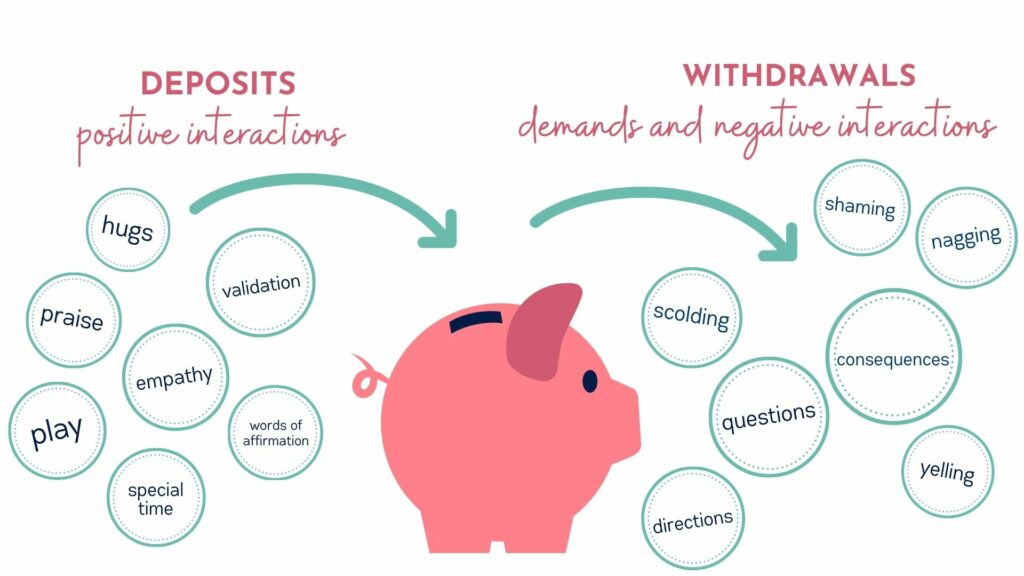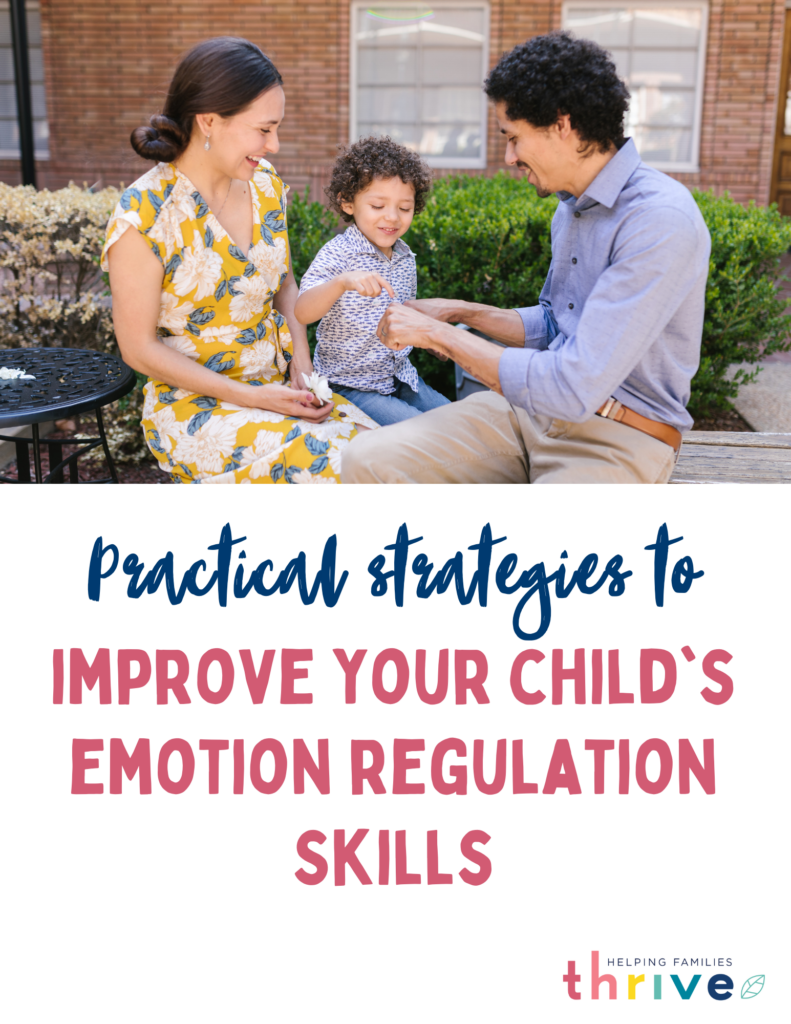
Have you ever given your child a seemingly simple instruction like, “Hey bud, put your shoes in the closet, please.” only to be met with a HUGE emotional or behavioral outburst?
When this happens, I’ll bet you feel a bit taken aback. You may wonder why some days that instruction is no problem and other days it sends your child over the edge with tantrums or other challenging behaviors. The concept of the Emotional Piggy Bank helps us understand this baffling experience and where we, as parents, need to begin our work. First, we need to create a healthy emotional balance with our child by increasing deposits into their emotional piggy bank through intentional, positive interactions.

Now, what do we do about the other side of this equation to support a healthy balance in the emotional piggy bank? We have to address the withdrawals.
What are emotional withdrawals?
Each question, command, consequence, or negative interaction is a withdrawal from your child’s emotional piggy bank. Often parents are unaware of how many demands and commands they are giving to their kids.
Research shows that parents give 17 commands in a 30 minutes period (Webster & Stratton, 2006). Kids with behavioral challenges are given over 2 times that amount! Clearly, more commands does not lead to better behavior. Similarly, while age-appropriate and evidence-based consequences have their place, research has shown that overuse of these tools can increase challenging behaviors and weaken parent-child relationships. Additionally, while asking our children thoughtful questions can increase connection, it’s important to recognize that questions are actually demands — which we expect our child to answer. Sometimes we pepper our kids with questions without realizing it!
You may be thinking, “Wait, I should never ask questions? No commands? My child doesn’t listen unless I raise my voice!”
Please hear us… not all withdrawals are bad! As parents, we have to give our children instructions, set boundaries, and, at times, issue age-appropriate consequences. Withdrawals are part of life. Protecting our children from any and all emotional withdrawals undermines resilience.
So what do we do?
Our priority is to make sure we build up enough emotional deposits, so that our children are resilient in the face of commands (which are part of life), undesired tasks (which are parts of life), and consequences (which are part of life).
You work so hard to create a healthy relationship with your child, we don’t want unnecessary or unwise withdrawals to send your child into emotional overdraft.
Let’s talk about some specific ways to help your child do the things you need them to do (such as get dressed, leave the park, clear the table), while minimizing the amount of money you’re taking out of the piggy bank!
3 ways to decrease emotional withdrawals
1. Replace unhealthy withdrawals with wise withdrawals
Not all withdrawals are created equal. Boundaries, natural and logical consequences, and evidence-based time-outs are well-researched tools to establish boundaries while enhancing child well-being. These are what we call WISE withdrawals.
Withdrawals like physical discipline (e.g., spanking), shaming, and chronic yelling/parent explosiveness cause a type of stress that has been found to be unhealthy for our children in the long-term. For example, a recent study from Harvard found that spanking can impact children’s brain development in ways similar to more severe forms of violence and abuse. Additionally, these negative parenting practices actually increase the very behaviors parents are trying to reduce. If these discipline approaches are already present in a family, the good news is that shifting strategies early is extremely powerful. You can be a firm, loving parent and commit to using discipline strategies found to enhance child and family well-being.
To reduce the use of negative parenting practices, start to notice when you feel yourself heating up in reaction to your child’s behavior, and then take space. We know this is easier said than done. It is okay to say, “Papa needs a minute. I’m getting heated.” and then to WALK AWAY so everyone’s brains can cool off. Staying right next to your child when you are losing your cool does not help anyone. Walking away is not weakness — it’s respect; it’s modeling.
2. Reduce commands by pausing before and after
Sit back a moment and think about ALL the directions and commands you give in your morning or evening routine. If there was a hidden camera and you got to watch a replay and tally the number of instructions you give, our guess is that you would be surprised. All of those “Get your shoes. Do you have your shoes yet? Keep eating! Hurry up, bud. Don’t run. Leave your sister alone. We need to go. Brush your teeth.” add up very quickly.
One way to make a big dent in the number of instructions you’re giving is to pause before you let that command pop out of your mouth.
Remember, every instruction we give as a parent is a commitment to follow through. Ask yourself, is the instruction you are about to give necessary? Pick your battles! Less commands in a day means your child is more likely to pay attention to what you are saying because you’re not just background noise to them anymore.
If the command is necessary, then after you give the instruction, PAUSE AGAIN! Unfortunately, one of the reasons we give this many commands is because we’ve actually taught our kids that they don’t have to listen until the 4th, 5th, or even 6th time we’ve asked! Oops! Additionally, we make so many unnecessary withdrawals from the piggy bank when we repeat commands over and over and over again. Count to 10 in your head after you give your child an instruction to give them time to process. For tools on improving cooperation through effective instructions get our cooperation guide.
Remember, kids — especially kids with big feelings — do not have very strong pause buttons in their brains yet. So, let’s start with ourselves. Let’s slow it down and model pausing before jumping into command mode.
3. Replace commands with visual routines
Many of the commands we give in a day are the same, day in and day out. Let’s outsource some of that repetitive work!

Write down the steps in your child’s morning or evening routine. Now add a picture for each step. This doesn’t need to be Pinterest-worthy stuff here! Post-its and stick figures are great. Now, in the morning, rather than verbally telling your kiddo each step, start to model how they can use their morning schedule to know what’s next. This sounds like, “It’s time for morning jobs! What’s first?” and point to the visual routine. When that step is complete, give a high five and move on to the next step.
Over time, let your child be more in charge of checking the next step as they go. This builds confidence and independence while giving you a break from being a command machine.
For more information on creating effective routines take a look at our our Essentials course and our Banishing Bedtime Battles mini-course.
Your job this week is to ask yourself, “am I making more deposits than withdrawals?” If not, commit to just one tool on this list that you can be more intentional about to reduce emotional withdrawals. Awareness is the first step! Lasting changes come slowly. You’ve got this.






24 Comments
Comments are closed.